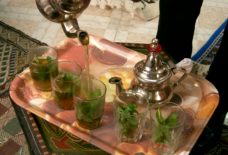The Surprising Algerian History of the Clementine
By: Claire Boyle / Arab America Contributing Writer
Introduction:
The Clementine is beloved by many for its easy-to-peel and often seedless nature, sweet taste, and the beautiful orange color of the fruit. During the fall and winter months, clementines can be easily found in grocery stores, kids’ lunchboxes, and on countertop spreads full of other winter fruits including pomegranates, avocadoes, kumquats, persimmons, and grapefruits, but did you know that this amazing little orange also has surprising origins in the Arab World?
What is a Clementine?
Clementines are small circular fruits that look like mini oranges. Clementines have a glossy orange and slightly bumpy skin like most citrus fruits do. On the inside, the fruit is separated into multiple sections like oranges, and if they are ripe, the slices will be incredibly sweet and delicious. Scientists have discovered that Clementines are a “hybrid between a willowleaf mandarin orange and a sweet orange.”
Surprising Arab Origins of the Clementine:
The Clementine’s surprising Arab origin is that the plant was originally found in “Algeria by a French missionary monk Clémont Rodier in the late nineteenth century.” Rodier worked in a “missionary orphanage by overseeing the citrus trees, and he ended up making grafts of the trees by joining the tissues of the plants together.” The story goes that people loved these little oranges and the orphans affectionately titled the fruits, “Clementines” after their founder, Clémont Rodier.
The tragic part of this story is that it seems the French have mostly been credited with creating this very popular fruit that is beloved by many. Unfortunately, many people will probably never know that the Clementine originated from the country of Algeria. It is time to set that record straight and properly credit the village of Misserghin, Algeria, as the one that birthed the world-renown fruit of the Clementine. While Rodier might have put the two types of plants together to create the hybrid that made the Clementine, it is undeniable that the dirt and land of Algeria birthed this little fruit.
During the late nineteenth century, the French were expanding their colonial regime, and the story of the Clementine’s origins is another item whose origins were never properly credited to the Arab World. Colonialism rears its ugly head in various shapes and forms including “exploiting a country economically.” While the Clementine has now become a favorite amongst Americans, and sometimes it feels as if the effects of colonialism are forgotten, it is important to think about how the missing credit that Algeria created this fruit has affected the country’s economy over the centuries. If Algeria was never credited as the birthplace of the Clementine, what else do we not know about this wonderful little fruit?
North Africa: The Clementine Region:
North Africa is known for its nature including vast landscapes, exquisite architecture, warm seas, and beautiful deserts, but perhaps, the one major unknown is that the region appears to be the world’s most prolific Clementine producer. Why is that? Well, the three major types of Clementines are originally from North Africa. Even to this day, the Clementine types of “Seedless, Monreal, and Sweetclems” can be found in North Africa!
The Clementine types grown in North Africa have specific qualities that are unique to each plant. For example, the Seedless variety is like the name says, and these are the most popular kind that is seen in stores. Furthermore, the Monreal type has the interesting ability to “self-pollinate, it has seeds and is a larger fruit.” Finally, the Sweetclems type is “smaller and tends to have ten slices within.”
The Clementine tends to be grown in Algeria, but one can also find these little orange goodies grown in Morocco. Clearly, Clementines are the pride and joy of North Africa, and unfortunately, that fact has been unknown for a long time.
How to Use Clementines in Cooking:
Clementines can be used in many different ways. The most common way is to pick up a bag from the grocery store, peel, and then eat them, but surprisingly, there are other uses than dropping a few in your daily lunchbox. Other common recipes including a Clementine Chicken with Sumac dish that is sometimes served with Lebanese Arak, and many scrumptious desserts that will make your tastebuds wanting to eat them instantly! Finally, you might even be able to substitute the Clementine’s zest, fruit, and some of its juice in place of Moroccan Orange Blossom Water.
Conclusion:
Perhaps, the next time you visit the store, there may be an exciting and prideful moment in the produce section after remembering that Clementines are a part of your Arab heritage. It is unfortunate that the history and true origins of the Clementine was forgotten for so long, but with this new information, you can be proud knowing that this beautiful little orange originally came from a country in the Arab World. Finally, check out the next article on the surprising Arab history of foods where we will uncover the origins of Tamarind in Sudan!
Check out Arab America’s blog here!
Claire Boyle is a contributing writer for Arab America. From January to June 2021, she was a senior intern for Arab America. Claire is a(n) historian, having earned a(n) MA in History, With Distinction, from DePaul University and a BA in Global Studies, Magna Cum Laude, with a Minor in Arabic, and an Emphasis in Interfaith Studies from Benedictine University. She currently works for the Arab America Foundation in membership and as an assistant. Claire enjoys writing about Arab World history and culture, particularly about Morocco, where she studied abroad many years ago, and the stories of Arab Americans.









